Study on the Coupling Degree of Urban Virtual and Substantive Vitality from the Perspective of “Scale-Vitality”—Taking the Changsha-Zhuzhou-Xiangtan Metropolitan Area as an Example
Abstract
1. Introduction
- What spatial distribution patterns characterize virtual–physical vitality in the ChangZhuTan metropolitan area?
- Does urban scale correlate with virtual–physical vitality, and do these correlations differ between the two vitality types?
- How does the coupling relationship manifest between urban scale and urban vitality?
- What spatial variations exist in the scale-vitality coupling degree across different subregions of the metropolitan area?
- Addressing the knowledge gap in scale-vitality coupling mechanisms within metropolitan contexts.
- Advancing urban virtual space studies by integrating urban scale with both virtual and physical vitality dimensions.
- Filling the research void regarding virtual–physical vitality interactions in the ChangZhuTan metropolitan area.
2. Overview of the Study Area and Data Sources
2.1. Overview of the Study Area
2.2. Data Sources
3. Research Methodology and Framework Construction
3.1. Variable Selection
- (1)
- Virtual Vitality Measurement
- (2)
- Substantive Vitality Measurement
- -
- Social vitality: Measured by shopping facility density (POI data), where higher concentrations signify active human flows [36].
- -
- Economic vitality: Represented by NPP-VIIRS night-time light intensity, with brighter pixels indicating stronger economic activity [25].
- -
- Cultural vitality: Evaluated through cultural facility density (POI data), where greater spatial clustering reflects enhanced cultural engagement [37].
- (3)
- Urban Scale Quantification
- -
- Population scale: Population density (persons/km2)
- -
- Land use scale: Total built-up area (m2)
- -
- Economic scale: GDP grid values (CNY 10,000/km2)
3.2. Research Methods
3.2.1. GIS Spatial Analysis Method
3.2.2. Correlation Analysis
3.2.3. Coupling Co-Ordination Degree Model Construction
3.3. Research Framework
4. Analysis of Empirical Results
4.1. Characteristics of City Scale in the Metropolitan Area
- (1)
- Population Scale Distribution
- (2)
- Land Use Scale Characteristics
- (3)
- Economic Scale Spatial Disparities
4.2. Urban Vitality Characteristics
4.2.1. Characterizing the Virtual Vitality Distribution of Metropolitan Areas Based on Web Punch Cards
4.2.2. Characterization of the Distribution of Substantive Vitality in Metropolitan Areas Based on Crowd Activity
- (1)
- Social Vitality Spatial Patterns
- (2)
- Economic Vitality Spatial Configuration
- (3)
- Cultural Vitality Spatial Features
4.3. Metropolitan Area Hierarchical Structure Model
5. Analysis of the Degree of Co-Ordination Between Urban Vitality and Scale Coupling
5.1. Analysis of the Correlation Between City Scale and Virtual–Substantive Vitality
- (1)
- Significant positive correlations (p < 0.001) exist between urban scale and both vitality dimensions, with stronger scale-substantive vitality linkages (β = 0.747) than scale-virtual vitality (β = 0.417).
- (2)
- Hierarchical analysis uncovers spatial heterogeneity in scale-vitality interactions across metropolitan zones.
5.2. Coupling Evaluation
5.2.1. Evaluation of the Coupling of Urban Scale and Virtual Vitality
- (1)
- High population density and intensive built environments in these areas contribute to elevated urban scale values.
- (2)
- Aging populations in older urban districts (e.g., Furong District in Changsha, Shifeng District in Zhuzhou) exhibit lower engagement with digital platforms, leading to mismatched scale-virtual vitality relationships.
5.2.2. Evaluation of the Coupling of Urban Scale and Substantive Vitality
6. The Coupling Promotion Path of Urban Scale and Vitality
6.1. Spatial Optimization: Multi-Level Synergies
6.2. Kinetic Energy Conversion: Virtual and Substantive Vitality Dual Drive
6.3. People-Oriented Governance: Balanced Vitality of Circles
7. Conclusions and Discussion
- (1)
- Core periphery structure of urban scale and vitality: the core urban area of Changsha exhibits high concentration in population, land use, and economic scale, followed by Zhuzhou and Xiangtan, while peripheral regions lag significantly.
- (2)
- Spatial divergence between virtual and substantive vitality: virtual vitality clusters predominantly in Changsha’s central districts without peripheral aggregation, whereas substantive vitality distributes across both core and selected peripheral areas.
- (3)
- Scale–vitality correlations: urban scale positively correlates with both vitality types, with stronger linkages to substantive vitality. Scale-driven vitality enhancement is more pronounced in core agglomerations.
- (4)
- Coupling dynamics: High coupling degrees exist between urban scale and dual vitality, particularly for virtual vitality. Coupling intensity transitions from high to low values radially from the core yet demonstrates an ascending trend.
- (1)
- Data constraints: the cross-sectional analysis, while revealing spatial patterns, lacks temporal dynamics of vitality evolution. Future studies should incorporate longitudinal data to track spatiotemporal vitality transitions.
- (2)
- Mechanistic gaps: focused on spatial analytics, this study is limited in exploring residents’ behaviors and socioeconomic drivers. Integrating surveys and interviews could unravel underlying social mechanisms.
- (3)
- Generalizability: comparative analyses across diverse metropolitan regions are needed to validate the universality of scale-vitality coupling principles.
Author Contributions
Funding
Institutional Review Board Statement
Informed Consent Statement
Data Availability Statement
Conflicts of Interest
References
- Mao, W.; Zhong, Y. Spatial pattern and influencing factors of urban vitality in the middle reaches of the yangtze river. World Reg. Stud. 2020, 29, 86–95. [Google Scholar] [CrossRef]
- Lynch, K. Good City Form; MIT Press: Cambridge, MA, USA, 1984; ISBN 978-0-262-62046-8. [Google Scholar]
- Jiang, D. The Theory of City Form Vitality; Southeast University Press: Nanjing, China, 2007; ISBN 978-7-5641-0627-0. [Google Scholar]
- Lu, J.; Zhang, F. Coordinated development of historical inheritance and the city’s vitality. New Archit. 2016, 32–36. [Google Scholar] [CrossRef]
- Implementation Plan for New Urbanization During the 14th Five-Year Plan Period. Available online: https://www.ndrc.gov.cn/fggz/fzzlgh/gjjzxgh/202207/t20220728_1332050.html (accessed on 22 February 2005).
- Sun, H.; Jiang, Y. Spatial heterogeneity of the impact of built environment on urban vitality: A case study of the central urban area of Nanjing. Geogr. Res. 2024, 43, 1700–1714. [Google Scholar]
- Jin, X.; Long, Y.; Sun, W.; Lu, Y.; Yang, X.; Tang, J. Evaluating Cities’ Vitality and Identifying Ghost Cities in China with Emerging Geographical Data. Cities 2017, 63, 98–109. [Google Scholar] [CrossRef]
- Liu, X.; Liu, Y. Influence Mechanism of Spatial and Temporal Evolution of Urban Vitality Under Shrinkage—A Case Study in Yichun. Master’s Thesis, Northeast Normal University, Changchun, China, 2020. [Google Scholar] [CrossRef]
- Tong, M. How urban fabric can help sustain the vitality of cities. Urban Plan. Forum 2014, 85–96. [Google Scholar] [CrossRef]
- Yang, G. Tracing research progress of urban vitality. Shanxi Archit. 2019, 45, 20–22. [Google Scholar] [CrossRef]
- Jacobs, J. The Death and Life of Great American Cities; Vintage Books: New York, NY, USA, 2012. [Google Scholar]
- Montgomery, J. Editorial Urban Vitality and the Culture of Cities. Plan. Pract. Res. 1995, 10, 101–110. [Google Scholar] [CrossRef]
- Still, B.; Simmonds, D. Parking Restraint Policy and Urban Vitality. Transp. Rev. 2000, 20, 291–316. [Google Scholar] [CrossRef]
- Ye, Y.; Li, D.; Liu, X. How Block Density and Typology Affect Urban Vitality: An Exploratory Analysis in Shenzhen, China. Urban Geogr. 2018, 39, 631–652. [Google Scholar] [CrossRef]
- Liu, L.; Xu, Y.; Jiang, S.; Wu, Q. Evaluation of urban vitality based on fuzzy matter-element model. Geogr. Geo-Inf. Sci. 2010, 26, 73–77. [Google Scholar]
- Nie, X.; Zhang, Y.; Zhou, W.; Su, H.; Yang, T.; Li, X.; Lan, S. Research status and trend of urban space vitality—Comparative analysis of chinese and english literature. J. Southwest Univ. Nat. 2021, 43, 147–155. [Google Scholar] [CrossRef]
- Liang, L.; Zeng, W.; Song, Y.; Shao, Z.; Liu, X. Urban Comprehensive Vitality Evaluation and Influencing Factors Analysis Considering Population Agglomeration and Emotional Intensity. J. Geo-Inf. Sci. 2022, 24, 1854–1866. [Google Scholar] [CrossRef]
- Li, Z.; Guo, Y.; Han, Z. Comparative research on statistical measurement of city vitality. World Surv. Res. 2021, 8, 74–80. [Google Scholar] [CrossRef]
- Zhang, W.; Huang, S.; Zhuo, H.; Tang, J. Measurement and evaluation to population vitality of characteristic towns in zhejiang province based on big data. Zhejiang Soc. Sci. 2022, 8, 22–33+156–157. [Google Scholar] [CrossRef]
- Ye, Y.; Zhuang, Y.; Zhang, L.; Van Nes, A. Designing urban spatial vitality from morphological perspective—A study based on quantified urban morphology and activities’ testing. Urban Plan. Int. 2016, 31, 26–33. [Google Scholar]
- Wang, J. Inclusiveness and sharing, explicit and implicit mutual learning, livability predicted: Historical prospect and contemporary creation of urban vitality. City Plan. Rev. 2019, 43, 9–16. [Google Scholar] [CrossRef]
- Luo, Q.; Wen, Z.; Yu, L. Developing a Dynamic Street Space in Small Towns by the Guidance of Environment-Behavior Studies: A Case Study on Zihu Town. Urban Dev. Stud. 2019, 26, 20–24,30. [Google Scholar] [CrossRef]
- Ye, Y.; Zhuang, Y. A Hypothesis of Urban Morphogenesis and Urban Vitality in Newly Built-up Areas: Analyses Based on Street Accessibility, Building Density and Functional Mixture. Urban Plan. Int. 2017, 32, 43–49. [Google Scholar] [CrossRef]
- Lu, B.; Zeng, Z.J.; Qian, Y.; Wei, W.X.; Yang, Y.M.; Li, H. Influence of road network form on urban vitality in the main urban area of lanzhou city. Arid Land Geogr. 2023, 46, 1333–1343. [Google Scholar] [CrossRef]
- Wang, E.; Zhou, J.; Yang, J.; Wang, Y.; Yang, P.; Wang, X. Impact of built environment on spatial differentiation of urban vitality at the subdistrict level based on mgwr: A case study of of shenyang central urban area. Geogr. Sci. 2024, 44, 1322–1331. [Google Scholar] [CrossRef]
- Yang, M.; Huang, X.; Song, T. A study on the evaluation of urban public space vitality based on “explicit and implicit mutual learning”: A case of park green space in Xi’an. Hum. Geogr. 2023, 38, 118–125+192. [Google Scholar] [CrossRef]
- Jiang, H.; Song, T.; Li, S. Deng Zhiping Spatial pattern characteristics of urban virtual-real vitality in the digitization context: A case study of guangzhou. Trop. Geogr. 2023, 43, 695–706. [Google Scholar] [CrossRef]
- Liu, L.; Zhou, T. A new understanding of the city scale theory. Econ. Surv. 2006, 22, 112–115. [Google Scholar] [CrossRef]
- Li, Y.; Huang, Q.; Cao, W. Assessing the pan-yangtze delta region’s coordination of urban efficiency and scale. Hum. Geogr. 2017, 32, 124–130. [Google Scholar] [CrossRef]
- Wang, G.; Li, F.; Liu, X.; Gao, N.; Gao, Y. New patterns of urbanization in the new development stage—The concept and identification standards of modern metropolitan areas. Urban Plan. Forum 2021, 2, 15–24. [Google Scholar] [CrossRef]
- National Development and Reform Commission. Response Letter on Acceptance of ChangZhuTan Metropolitan Area Development Plan (NDRC Planning [2022] No. 199); National Development and Reform Commission: Beijing, China, 2022.
- National Development and Reform Commission. Urbanization’s Second Half: Releasing Metropolitan Regions’ Full Potential; National Development and Reform Commission: Beijing, China, 2024.
- Hunan Provincial People’s Government Hunan Provincial People’s Government on the Issuance of the Development Plan for Changzhutan Metropolitan Area; Hunan Provincial People’s Government: Changsha, China, 2022.
- Zhang, Y.; Zhao, H.; Long, Y. CMAB: A Multi-Attribute Building Dataset of China. Sci. Data 2025, 12, 430. [Google Scholar] [CrossRef]
- Shan, R.; Zhang, S. The vitality assessment of renewed historic built environment and a discussion on regeneration strategies: The cases of tianzifang, xintiandi, and yuyuan tourist mall in shanghai. Urban Plan. Forum 2021, 79–86. [Google Scholar] [CrossRef]
- Ma, L.; Xiu, C. Research on the matching relationship between residential and commercial space in shenyang based on shopping trip. Hum. Geogr. 2022, 37, 63–70. [Google Scholar] [CrossRef]
- Wang, N.; Wu, W.J.; Li, S.; Wang, H.; Peng, Z. Spatial features of urban vitality and the impact of built environment on them based on multi-source data: A case study of shenzhen. Trop. Geogr. 2021, 41, 1280–1291. [Google Scholar] [CrossRef]
- Ding, X.H.; Luo, B.; Zhou, H.T.; Chen, Y.H. Generalized solutions for advection–dispersion transport equations subject to time-and space-dependent internal and boundary sources. Comput. Geotech. 2025, 178, 106944. [Google Scholar] [CrossRef]
- Zhou, Y. Recommendations on Clarifying the Concept of Towns and Cities and the Caliber of Urban Population Statistics in China. City Plan. Rev. 1986, 9, 10–15. [Google Scholar]
- Guo, X.; Huang, G. A Preliminary Investigation of the Notion of a Metropolitan Region and the Parameters That Define It. Contemp. Finance Econ. 2006, 79–83. [Google Scholar] [CrossRef]
- Wang, C.; Sheng, J.; Leng, B.; Yi, Z. Metropolitan Area Layers and Their Delimitation Methods and the Practice of Chongqing. Planners 2023, 39, 36–43. [Google Scholar] [CrossRef]
- Qian, Z. The concept of metropolitan regionand its delineation. Planners 2022, 38, 152–156. [Google Scholar] [CrossRef]
- Ministry of Natural Resources Code of Practice for Territorial Spatial Planning of Metropolitan Region. Available online: https://www.cacp.org.cn/u/cms/www/202109/10161846vnu6.pdf (accessed on 22 February 2025).


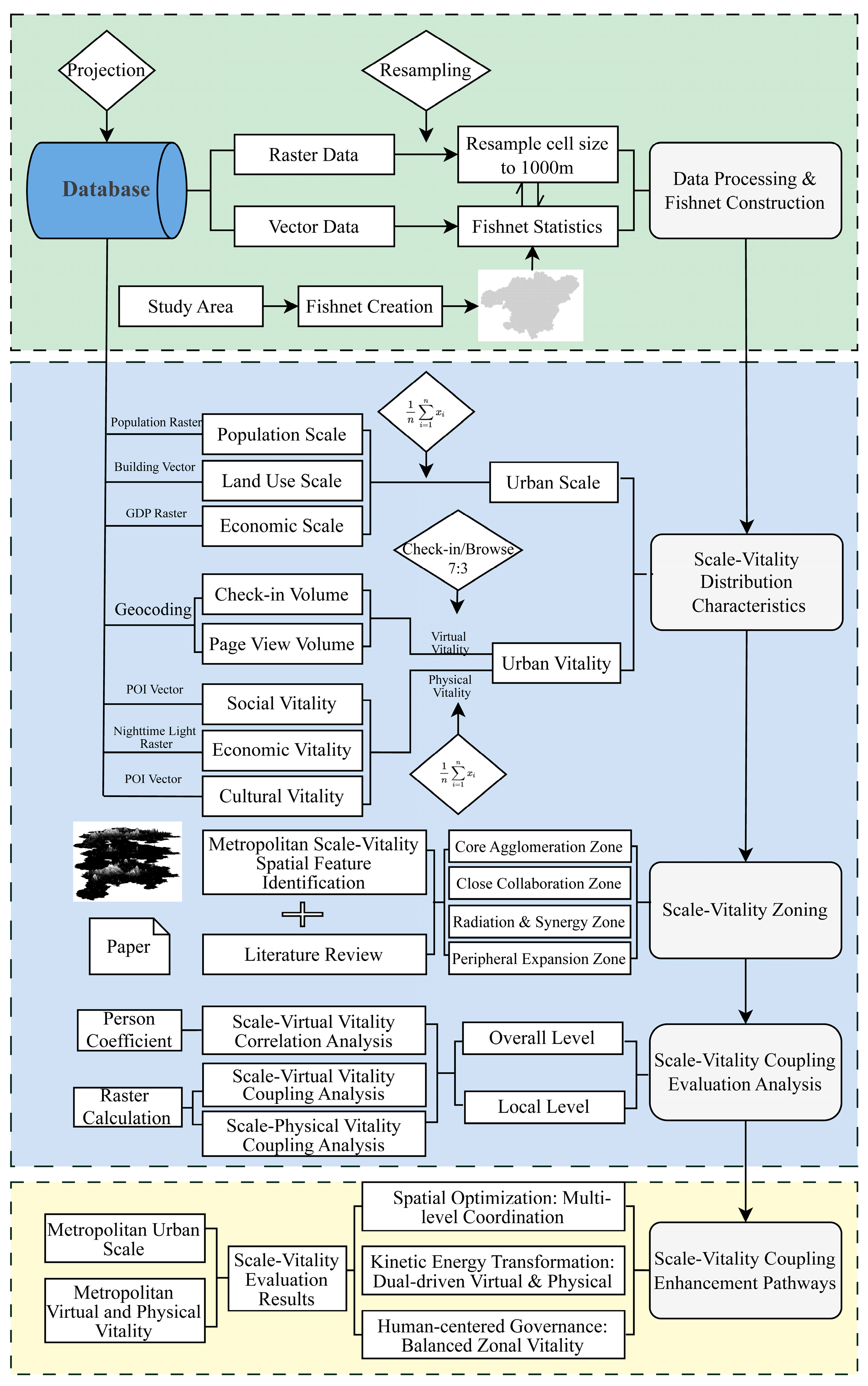
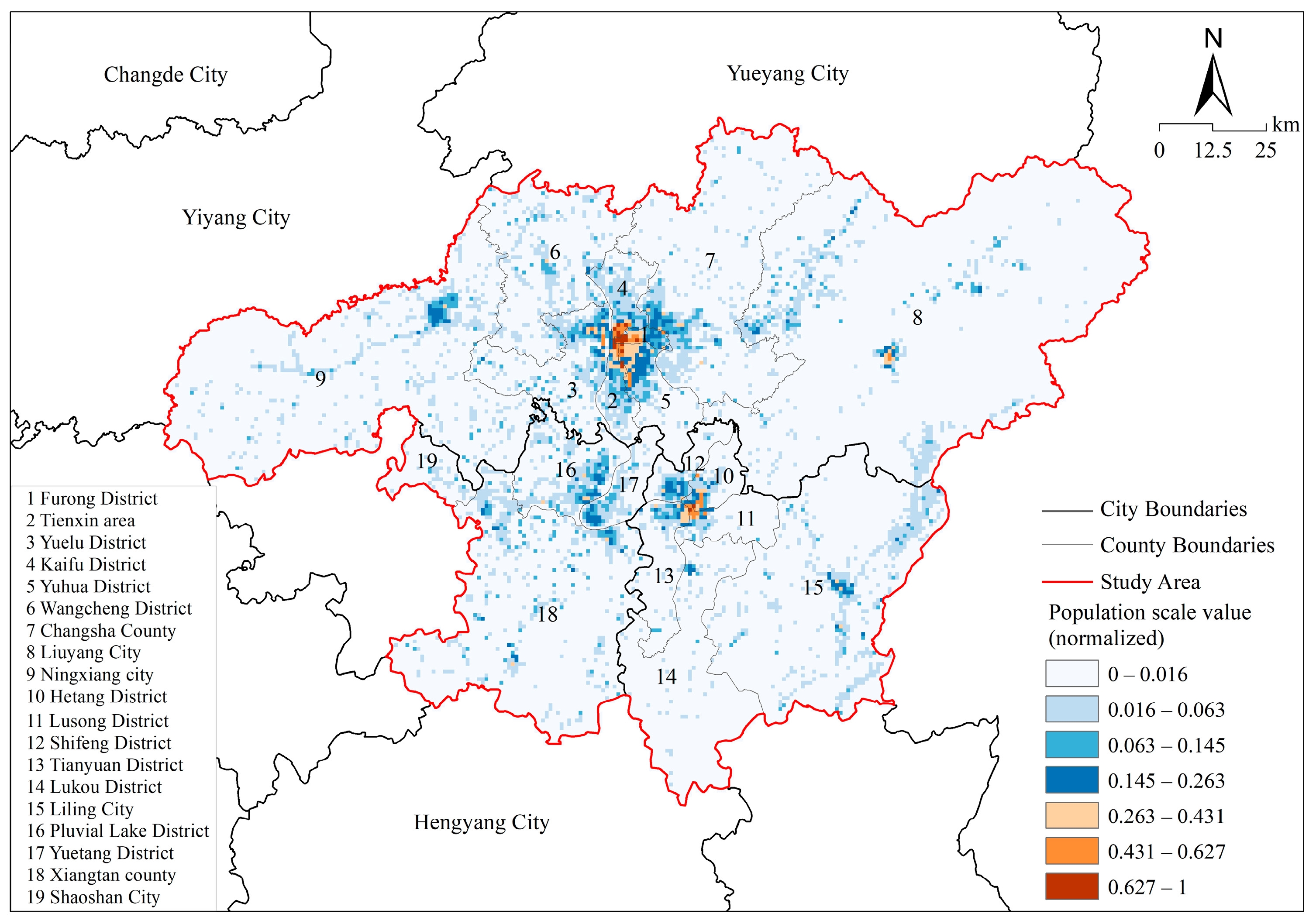
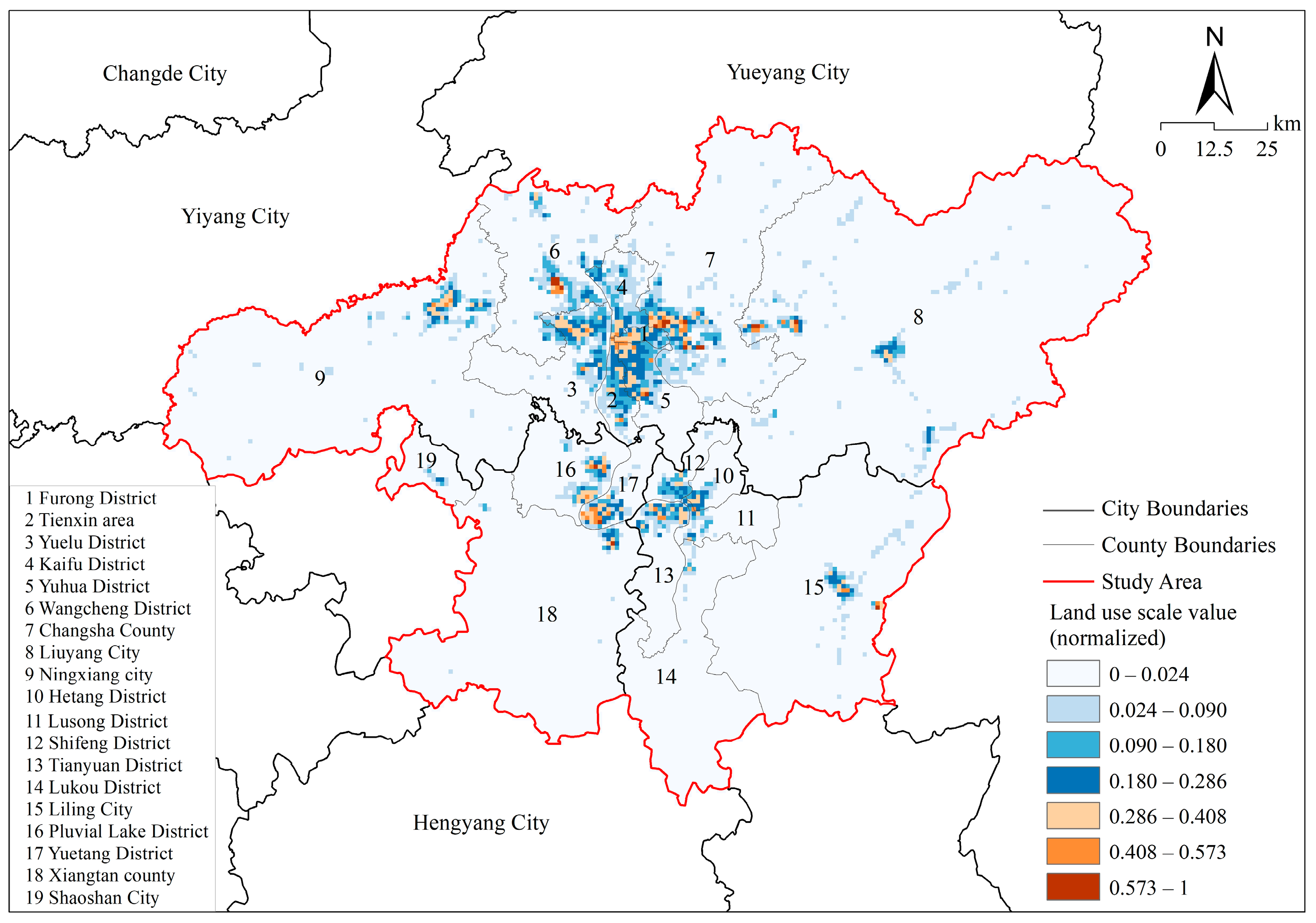
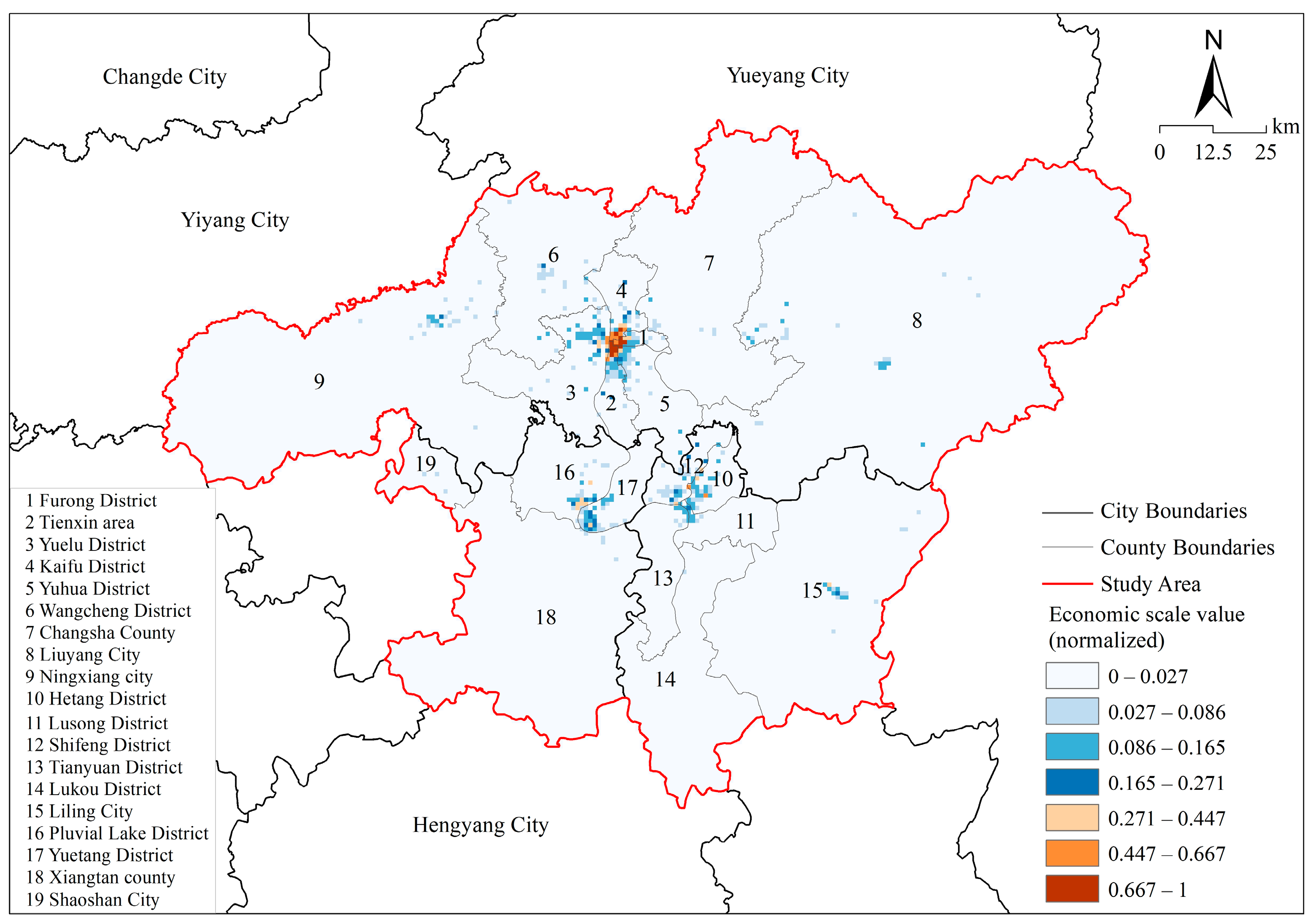
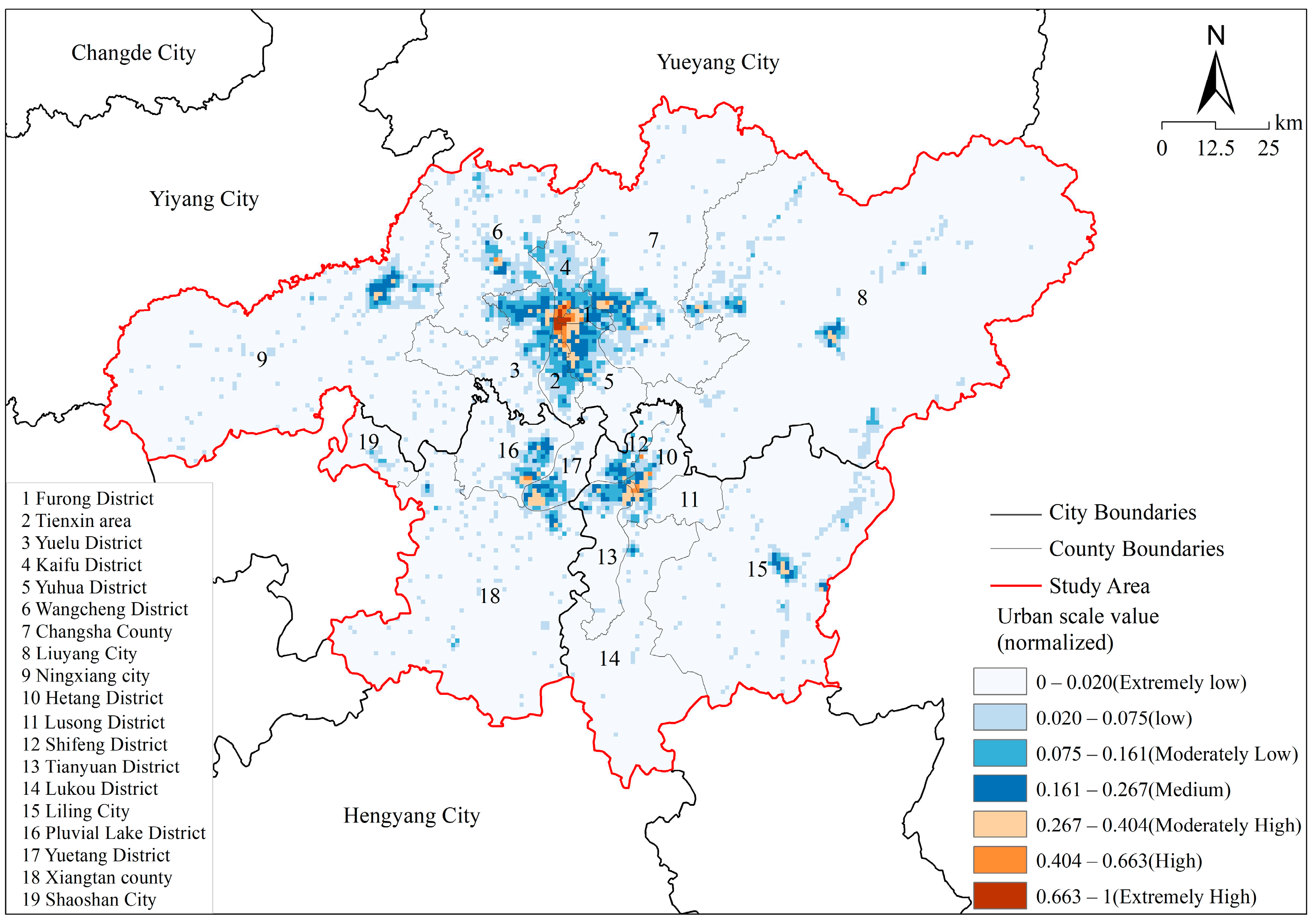
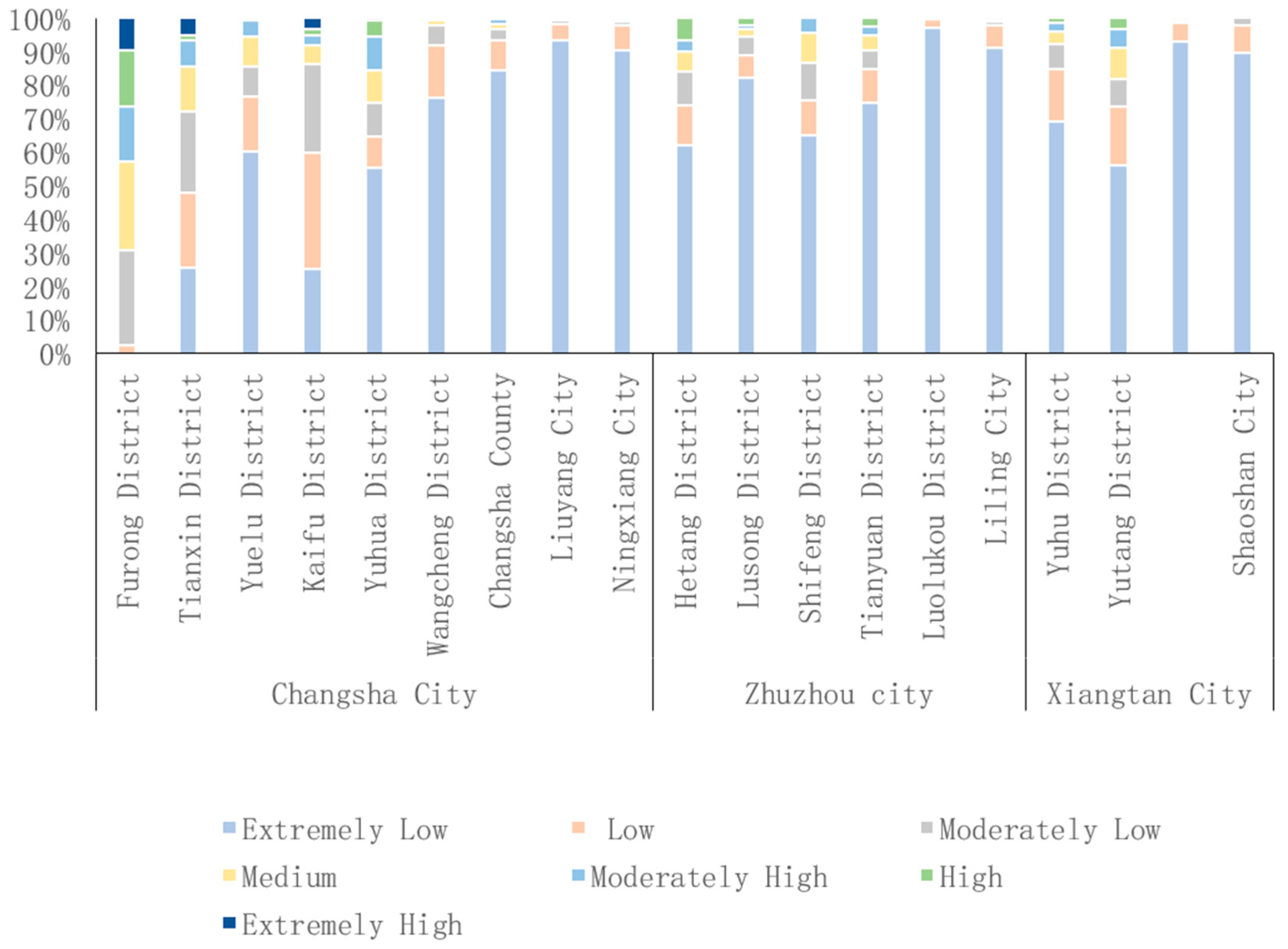
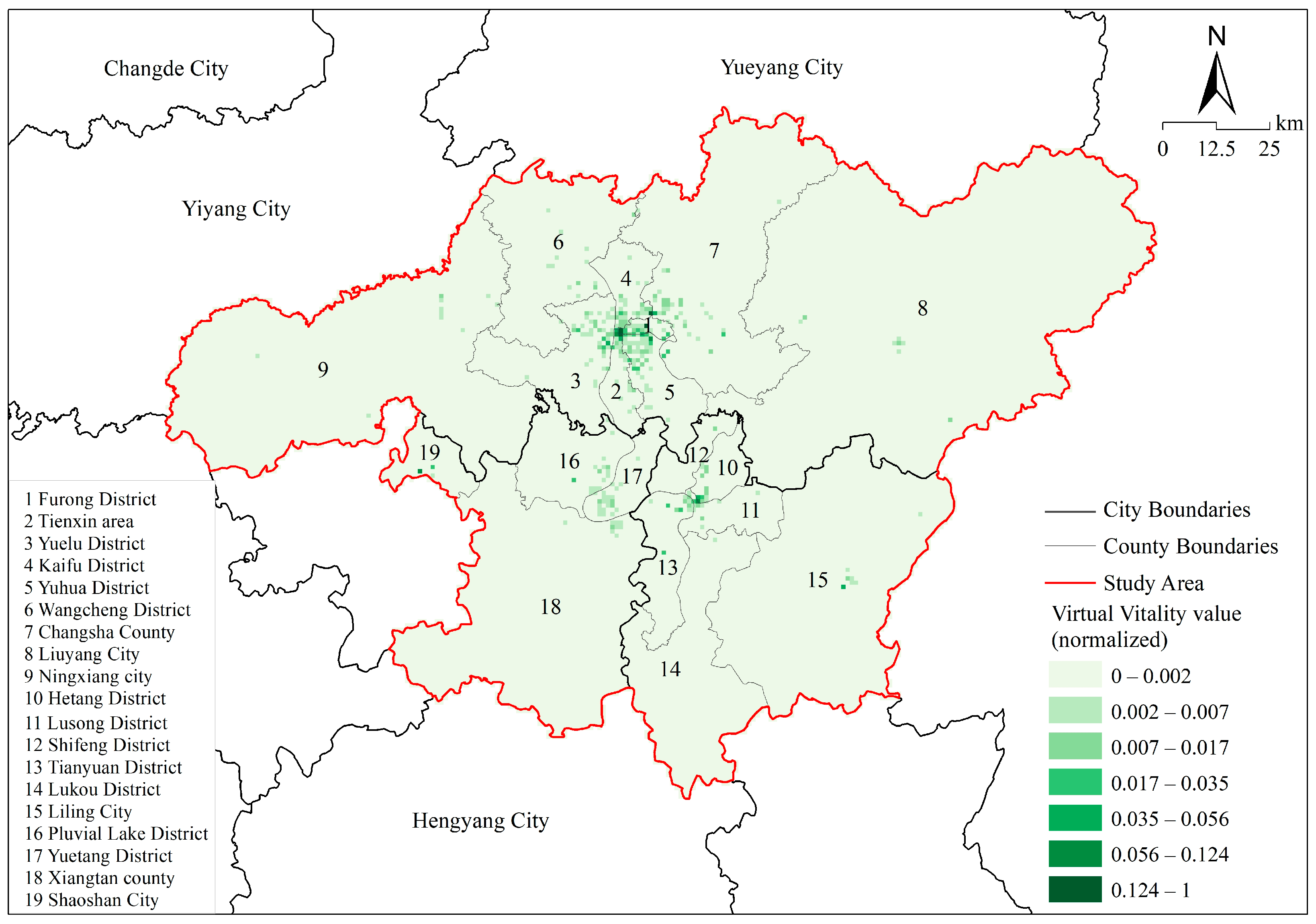
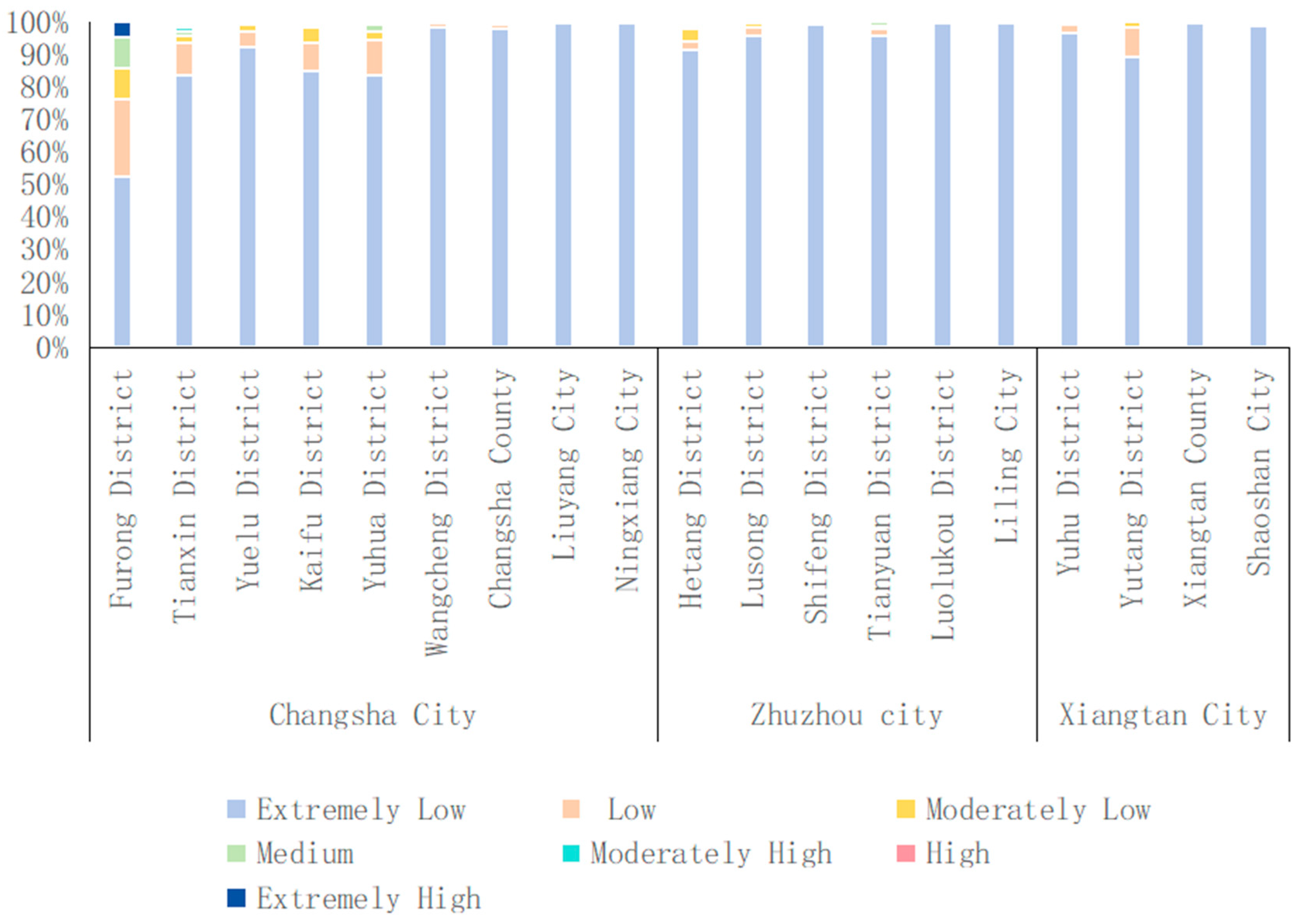
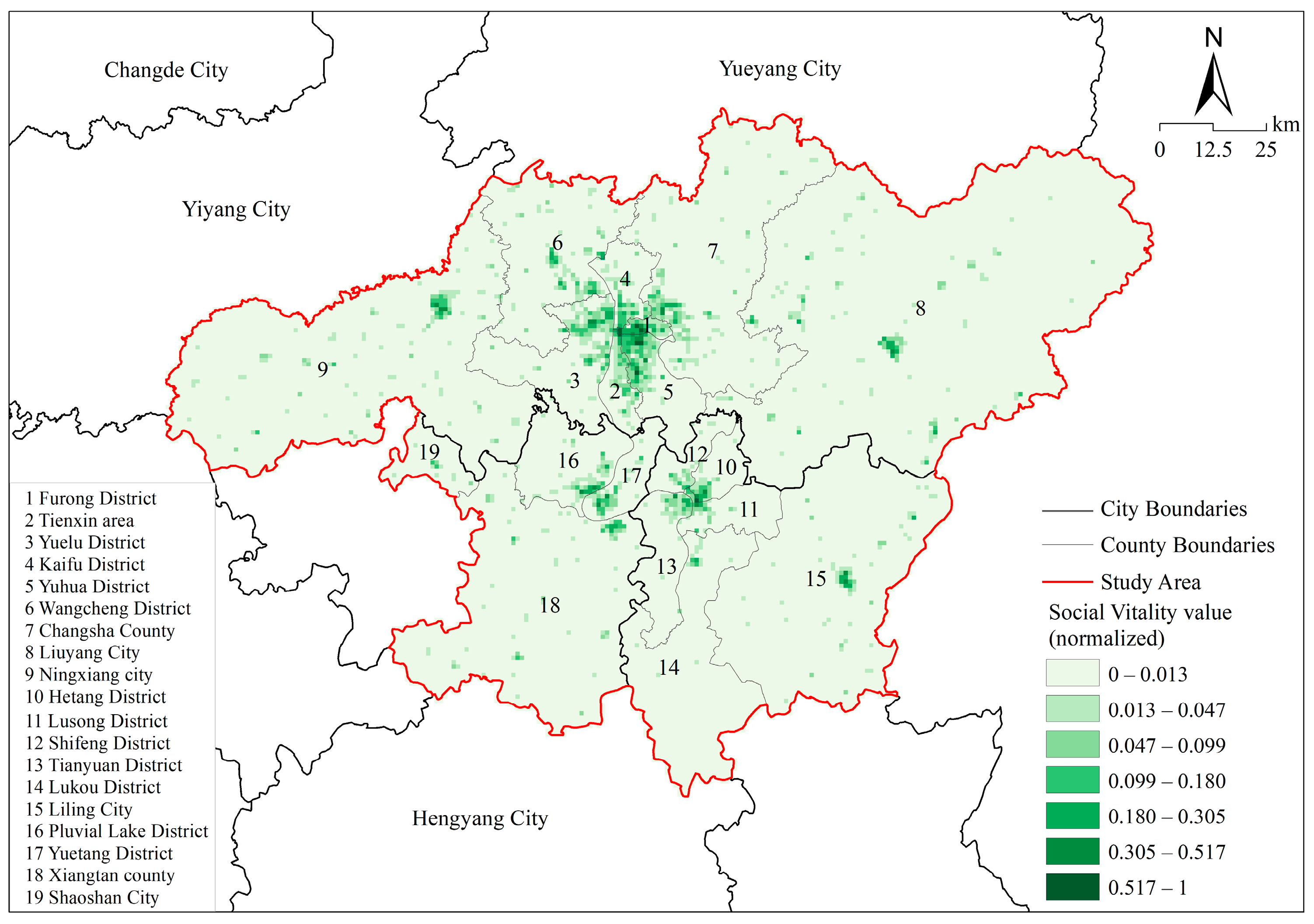
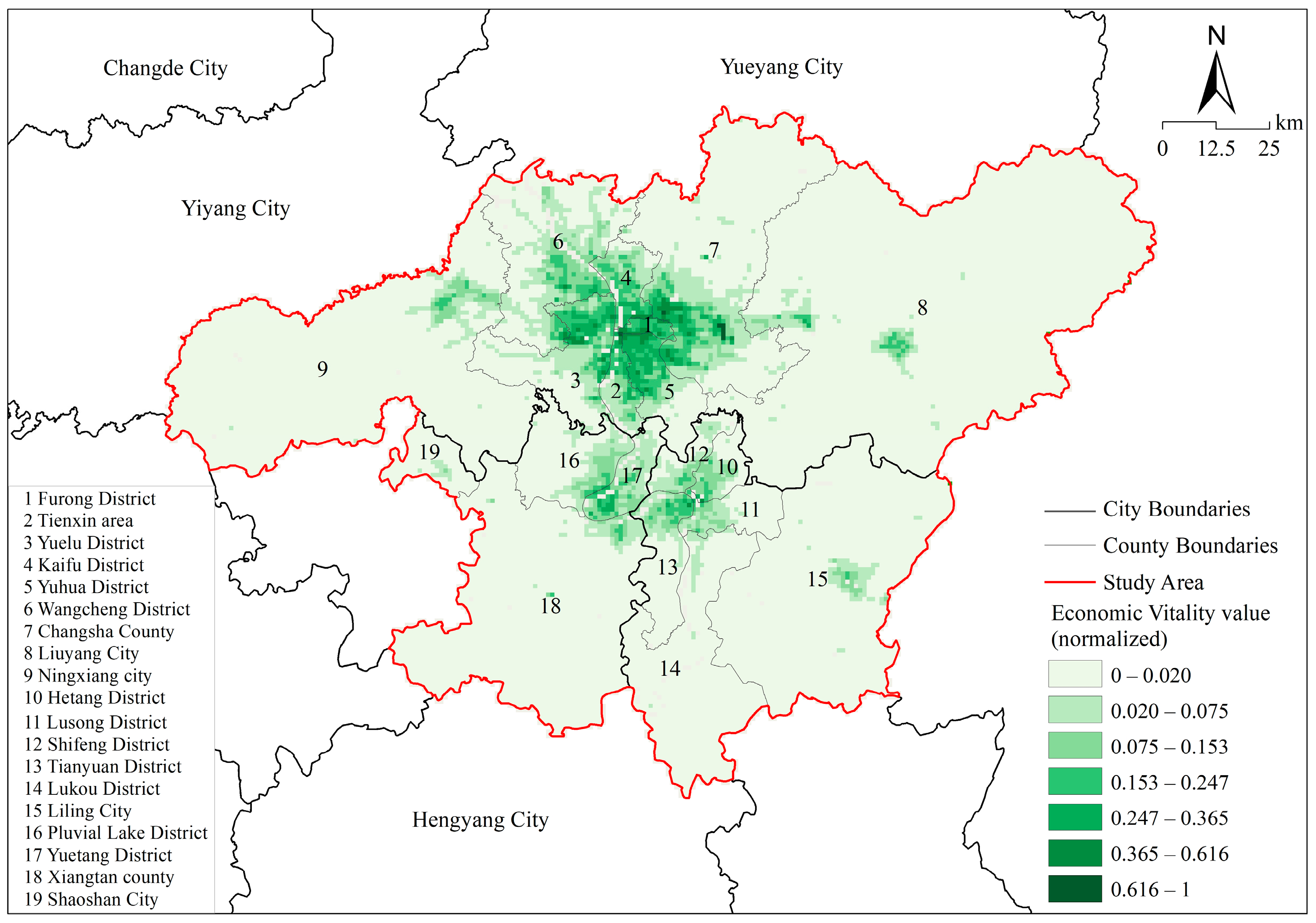
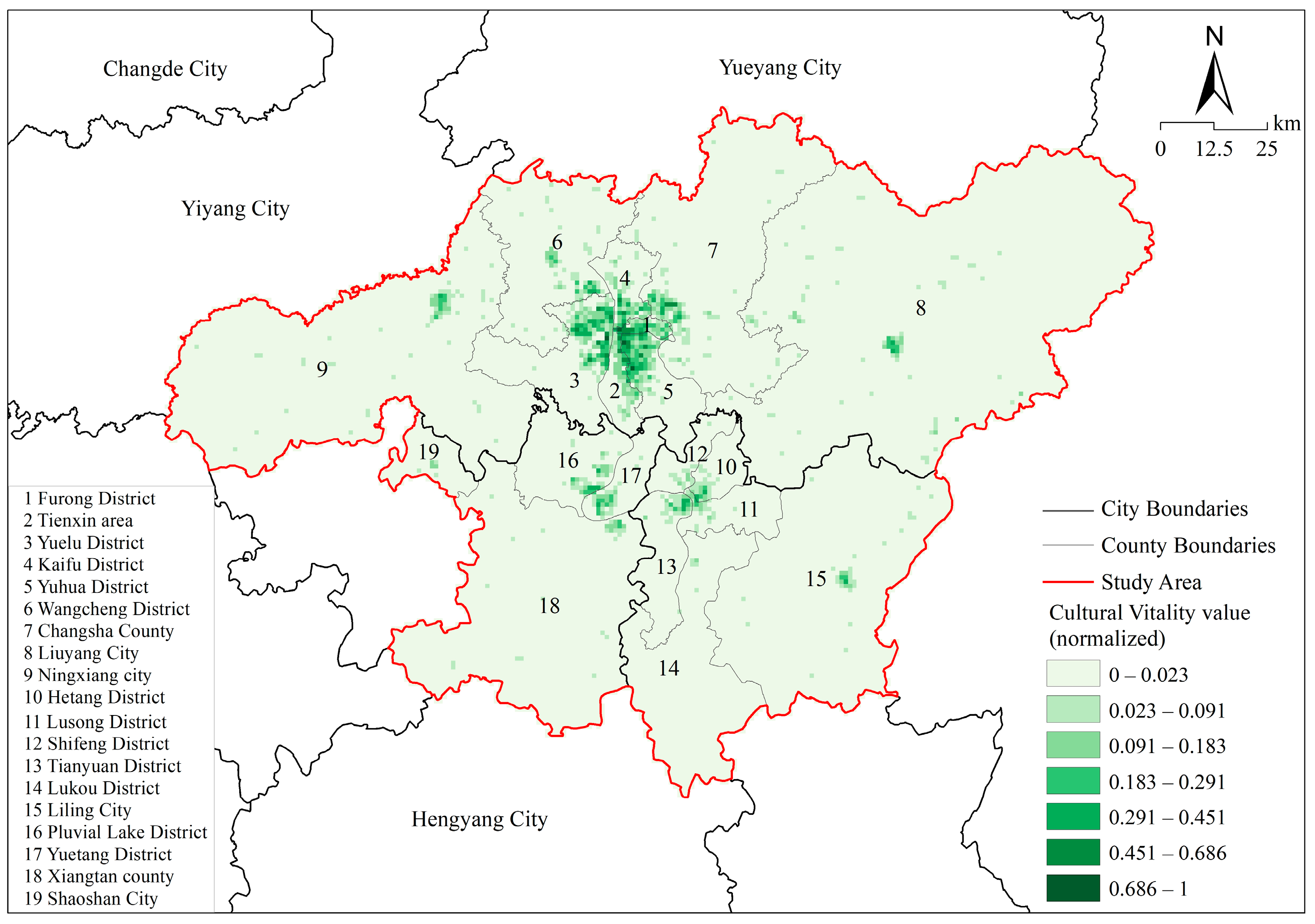
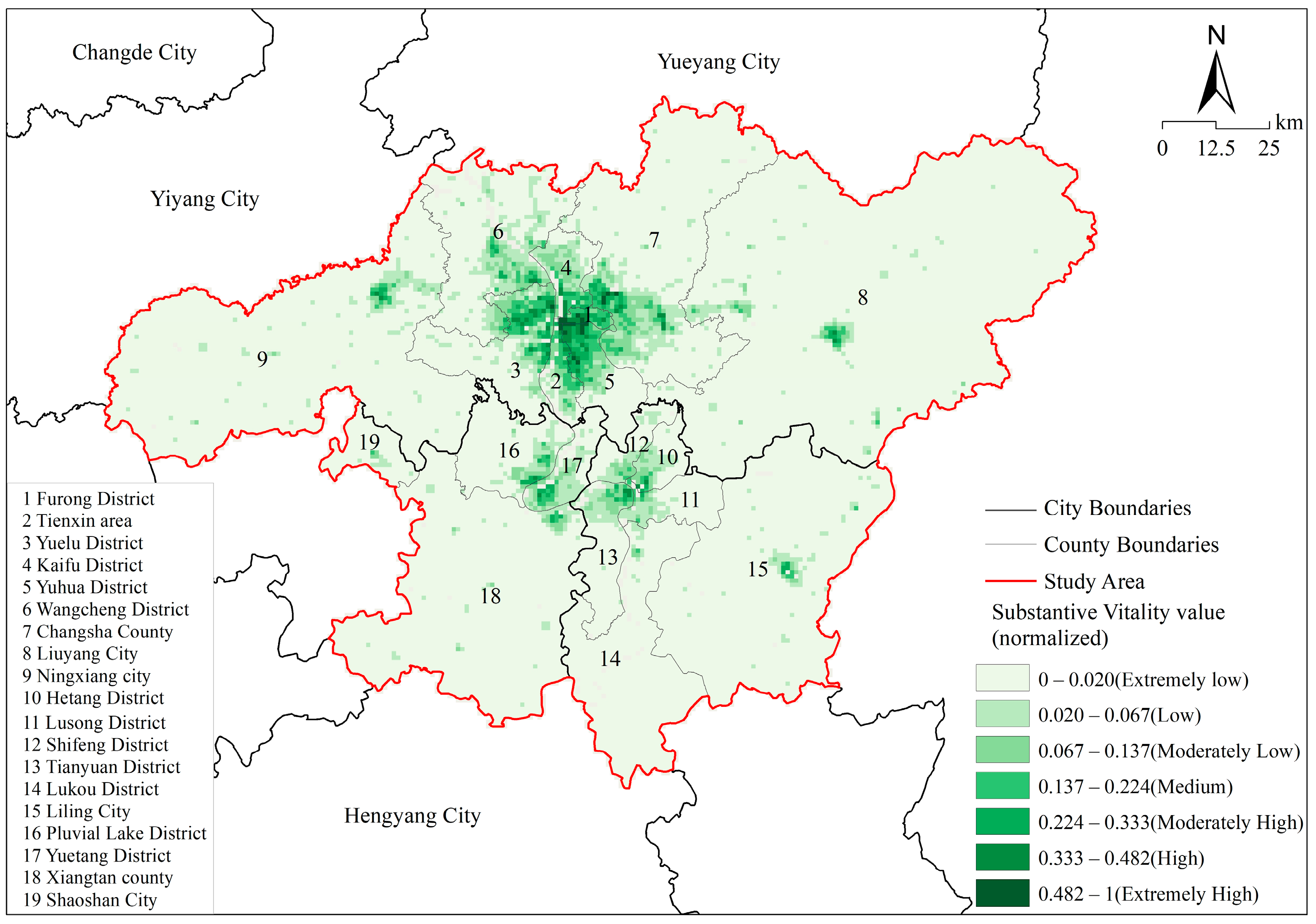
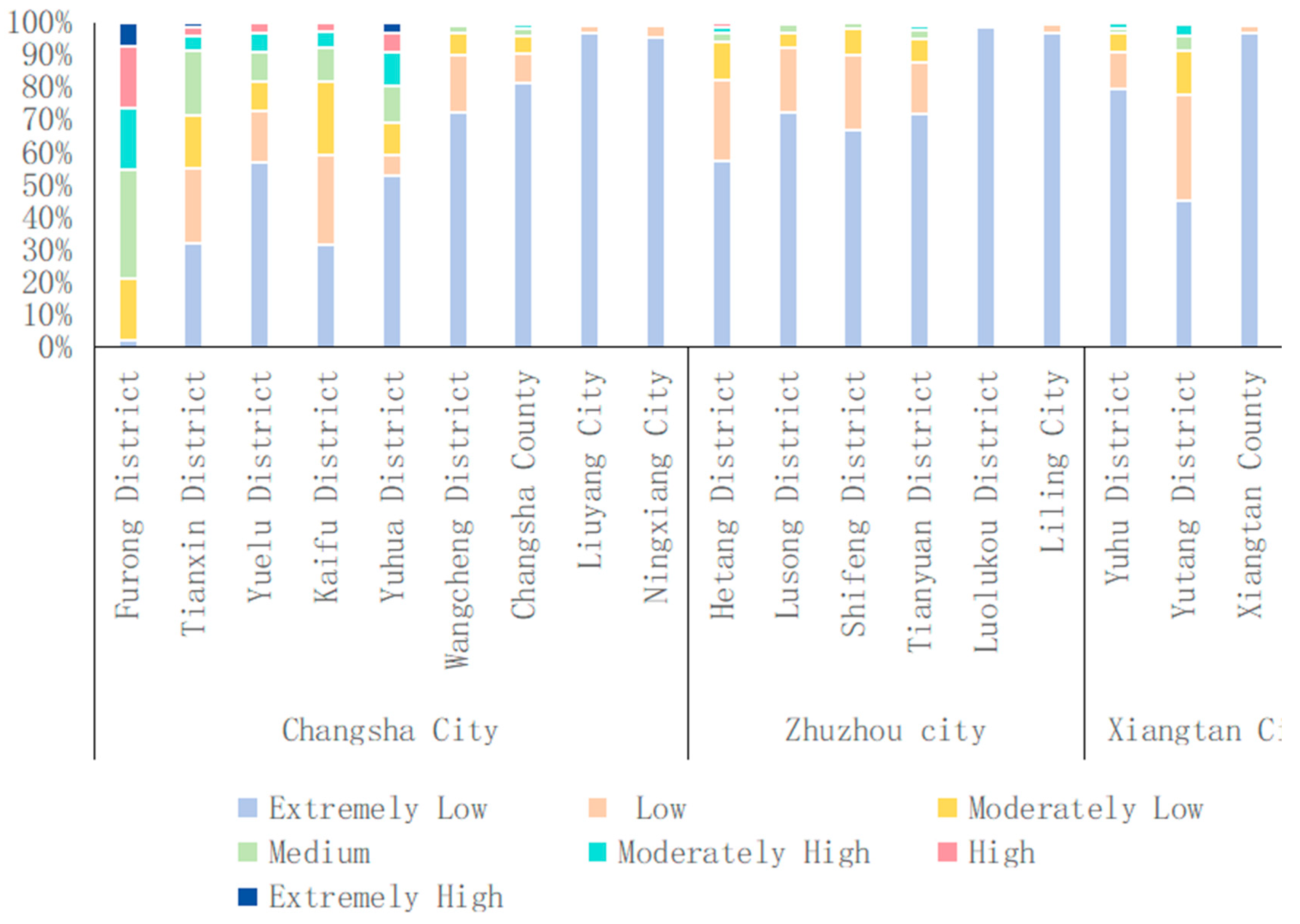
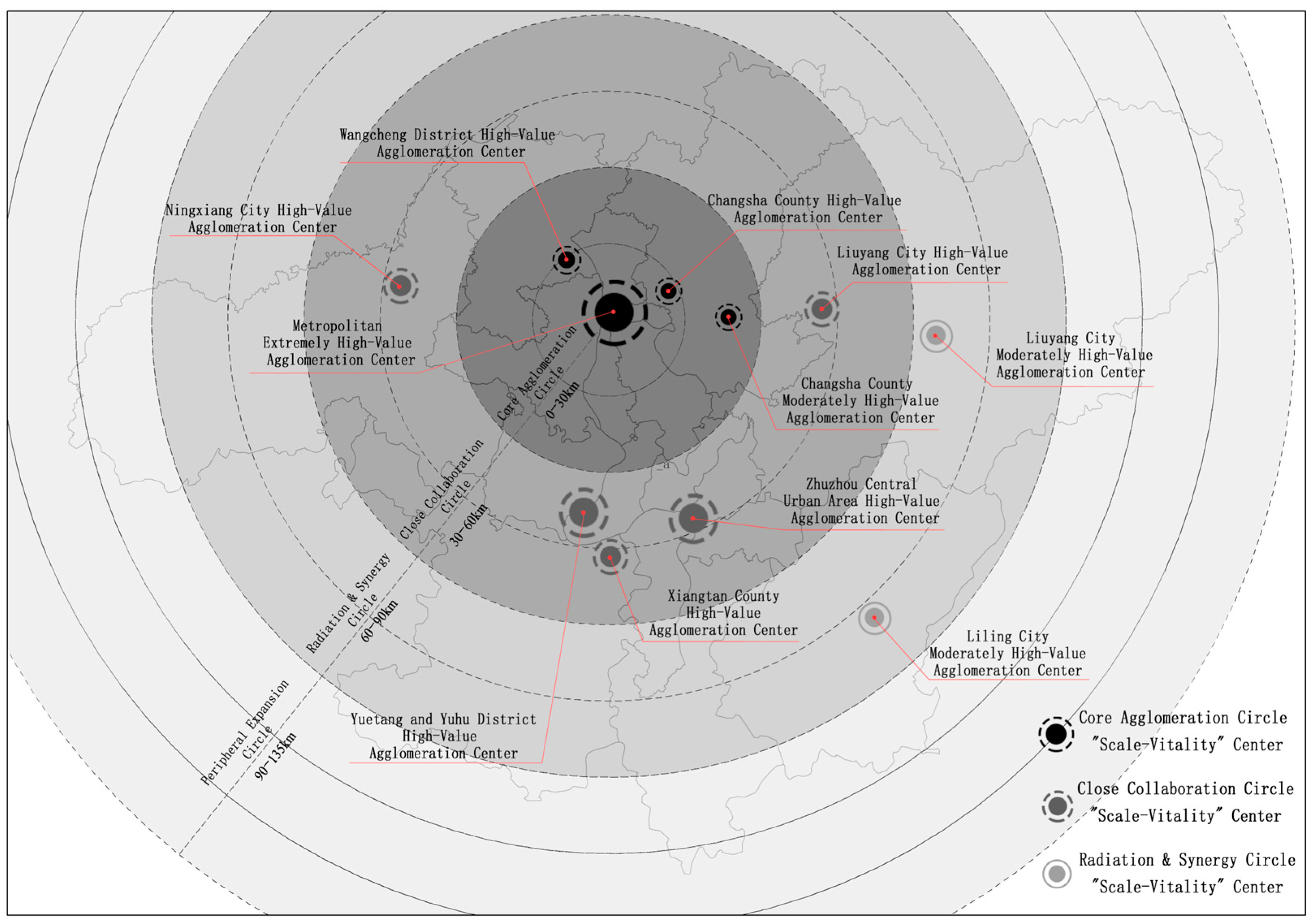

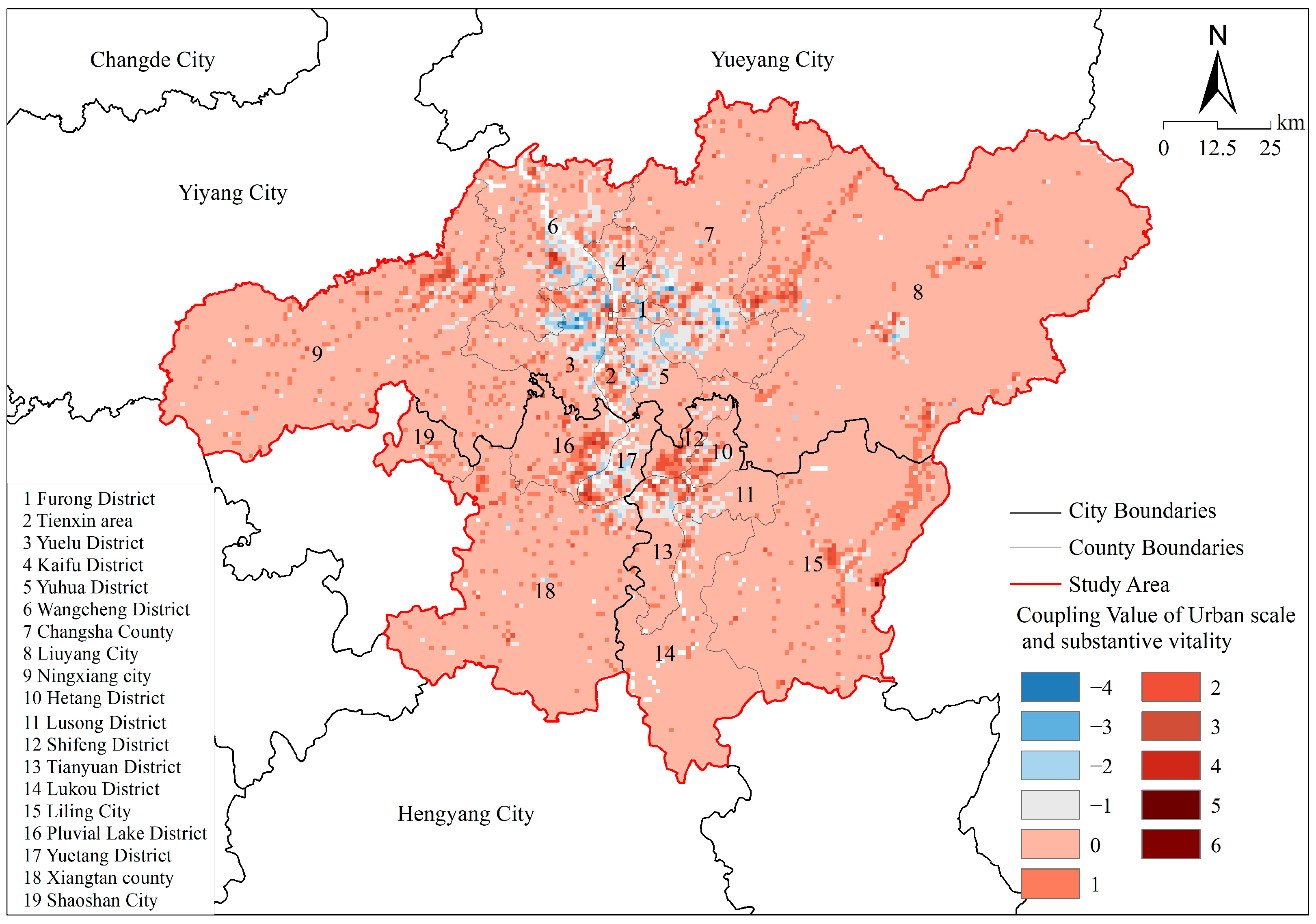

| System Level | Subsystem Level | Indicator Level | Quantification Method | Data Source |
|---|---|---|---|---|
| City scale | Size of population | population grid | population/space unit area | Geo-Remote Sensing Ecological Network (2024) |
| Size of the site | Scale of construction | Gross floor area of buildings in cell/spatial unit area | Google Earth image data (2022–2024) | |
| Scale of the economy | GDP grid | Million dollars/square kilometer | Geo-Remote Sensing Ecological Network (2024) | |
| Urban vitality | Virtual vitality | The amount of jitterbug punching | Total number of punches in the cell/space unit area | New Shake official website (2024) |
| Jitterbug views | Total number of views in cell/space unit area | New Shake official website (2024) | ||
| Substantive vitality | social vitality | Number of shopping facilities POI in cell/space unit area | Gaode Maps Open Platform (2024) | |
| economic vitality | Night-time Lighting Index | NPP-VIIRS (2024) | ||
| cultural vitality | Number of cultural facilities POI in cell/area of space unit | Gaode Maps Open Platform (2024) |
| Name of Prefecture-Level City | District and County Names | Extremely Low | Low | Moderately Low | Medium | Moderately High | High | Extremely High |
|---|---|---|---|---|---|---|---|---|
| Changsha City | Furong District | 0 (0.00) | 1 (2.38) | 12 (28.57) | 11 (26.19) | 7 (16.67) | 7 (16.67) | 4 (9.52) |
| Tianxin District | 36 (0.00) | 31 (2.38) | 34 (28.57) | 19 (26.19) | 11 (16.67) | 2 (16.67) | 7 (9.52) | |
| Yuelu District | 325 (25.71) | 88 (22.14) | 47 (24.29) | 48 (13.57) | 26 (7.86) | 4 (1.43) | 0 (5.00) | |
| Kaifu District | 48 (60.41) | 65 (16.36) | 50 (8.74) | 11 (8.92) | 5 (4.83) | 4 (0.74) | 6 (0.00) | |
| Yuhua District | 162 (25.40) | 27 (34.39) | 29 (26.46) | 29 (5.82) | 29 (2.65) | 14 (2.12) | 2 (3.17) | |
| Wangcheng District | 760 (55.48) | 155 (9.25) | 59 (9.93) | 16 (9.93) | 4 (9.93) | 3 (4.79) | 0 (0.68) | |
| Changsha County | 1533 (76.23) | 163 (15.55) | 60 (5.92) | 31 (1.60) | 23 (0.40) | 6 (0.30) | 0 (0.00) | |
| Liuyang City | 4806 (84.42) | 249 (8.98) | 50 (3.30) | 17 (1.71) | 13 (1.27) | 4 (0.33) | 0 (0.00) | |
| Ningxiang City | 2775 (93.52) | 220 (4.85) | 32 (0.97) | 18 (0.33) | 18 (0.25) | 0 (0.08) | 0 (0.00) | |
| Zhu Zhou City | Hetang District | 94 (90.60) | 18 (7.18) | 15 (1.04) | 9 (0.59) | 5 (0.59) | 10 (0.00) | 0 (0.00) |
| Lusong District | 180 (62.25) | 15 (11.92) | 12 (9.93) | 5 (5.96) | 2 (3.31) | 5 (6.62) | 0 (0.00) | |
| Shifeng District | 109 (82.19) | 17 (6.85) | 19 (5.48) | 15 (2.28) | 7 (0.91) | 0 (2.28) | 0 (0.00) | |
| Tianyuan District | 243 (65.27) | 33 (10.18) | 18 (11.38) | 15 (8.98) | 8 (4.19) | 8 (0.00) | 0 (0.00) | |
| Luolukou District | 1073 (74.77) | 25 (10.15) | 1 (5.54) | 3 (4.62) | 1 (2.46) | 0 (2.46) | 0 (0.00) | |
| Liling City | 2027 (97.28) | 153 (2.27) | 23 (0.09) | 12 (0.27) | 8 (0.09) | 3 (0.00) | 0 (0.00) | |
| Xiangtan City | Yuhu District | 308 (91.06) | 70 (6.87) | 32 (1.03) | 17 (0.54) | 12 (0.36) | 6 (0.13) | 0 (0.00) |
| Yutang District | 117 (69.21) | 36 (15.73) | 17 (7.19) | 20 (3.82) | 11 (2.70) | 7 (1.35) | 0 (0.00) | |
| Xiangtan County | 2084 (56.25) | 123 (17.31) | 22 (8.17) | 8 (9.62) | 3 (5.29) | 0 (3.37) | 0 (0.00) | |
| Shaoshan City | 217 (93.04) | 20 (5.49) | 5 (0.98) | 0 (0.36) | 0 (0.13) | 0 (0.00) | 0 (0.00) | |
| Summary | 16,897 (86.47) | 1509 (7.72) | 537 (2.75) | 304 (1.56) | 193 (0.99) | 83 (0.42) | 19 (0.10) | |
| Name of Prefecture-Level City | District and County Names | Extremely Low | Low | Moderately Low | Medium | Moderately High | High | Extremely High |
|---|---|---|---|---|---|---|---|---|
| Changsha City | Furong District | 22 (52.38) | 10 (23.81) | 4 (9.52) | 4 (9.52) | 0 (0.00) | 0 (0.00) | 2 (4.76) |
| Tianxin District | 117 (83.57) | 14 (10.00) | 3 (2.14) | 2 (1.43) | 2 (1.43) | 1 (0.71) | 1 (0.71) | |
| Yuelu District | 497 (92.38) | 26 (4.83) | 11 (2.04) | 3 (0.56) | 1 (0.19) | 0 (0.00) | 0 (0.00) | |
| Kaifu District | 161 (85.19) | 16 (8.47) | 9 (4.76) | 2 (1.06) | 0 (0.00) | 0 (0.00) | 1 (0.53) | |
| Yuhua District | 245 (83.90) | 31 (10.62) | 8 (2.74) | 6 (2.05) | 1 (0.34) | 0 (0.00) | 1 (0.34) | |
| Wangcheng District | 983 (98.60) | 11 (1.10) | 3 (0.30) | 0 (0.00) | 0 (0.00) | 0 (0.00) | 0 (0.00) | |
| Changsha County | 1783 (98.18) | 17 (0.94) | 12 (0.66) | 3 (0.17) | 1 (0.06) | 0 (0.00) | 0 (0.00) | |
| Liuyang City | 5131 (99.84) | 5 (0.10) | 3 (0.06) | 0 (0.00) | 0 (0.00) | 0 (0.00) | 0 (0.00) | |
| Ningxiang City | 3053 (99.67) | 9 (0.29) | 1 (0.03) | 0 (0.00) | 0 (0.00) | 0 (0.00) | 0 (0.00) | |
| Zhuzhou city | Hetang District | 138 (91.39) | 4 (2.65) | 6 (3.97) | 1 (0.66) | 1 (0.66) | 1 (0.66) | 0 (0.00) |
| Lusong District | 210 (95.89) | 6 (2.74) | 2 (0.91) | 1 (0.46) | 0 (0.00) | 0 (0.00) | 0 (0.00) | |
| Shifeng District | 166 (99.40) | 0 (0.00) | 1 (0.60) | 0 (0.00) | 0 (0.00) | 0 (0.00) | 0 (0.00) | |
| Tianyuan District | 312 (96.00) | 6 (1.85) | 4 (1.23) | 3 (0.92) | 0 (0.00) | 0 (0.00) | 0 (0.00) | |
| Luolukou District | 1102 (99.91) | 1 (0.09) | 0 (0.00) | 0 (0.00) | 0 (0.00) | 0 (0.00) | 0 (0.00) | |
| Liling City | 2219 (99.69) | 5 (0.22) | 1 (0.04) | 0 (0.00) | 1 (0.04) | 0 (0.00) | 0 (0.00) | |
| Xiangtan City | Yuhu District | 430 (96.63) | 12 (2.70) | 2 (0.45) | 1 (0.22) | 0 (0.00) | 0 (0.00) | 0 (0.00) |
| Yutang District | 186 (89.42) | 19 (9.13) | 3 (1.44) | 0 (0.00) | 0 (0.00) | 0 (0.00) | 0 (0.00) | |
| XiangtanCounty | 2231 (99.60) | 8 (0.36) | 1 (0.04) | 0 (0.00) | 0 (0.00) | 0 (0.00) | 0 (0.00) | |
| Shaoshan City | 239 (98.76) | 1 (0.41) | 0 (0.00) | 1 (0.41) | 0 (0.00) | 1 (0.41) | 0 (0.00) | |
| Summary | 19,225 (98.38) | 201 (1.03) | 74 (0.38) | 27 (0.14) | 7 (0.04) | 3 (0.02) | 5 (0.03) | |
| Name of Prefecture-Level City | District and County Names | Extremely Low | Low | Moderately Low | Medium | Moderately High | High | Extremely High |
|---|---|---|---|---|---|---|---|---|
| Changsha City | Furong District | 1 (2.38) | 0 (0.00) | 8 (19.05) | 14 (33.33) | 8 (19.05) | 8 (19.05) | 3 (7.14) |
| Tianxin District | 45 (32.14) | 32 (22.86) | 23 (16.43) | 28 (20.00) | 6 (4.29) | 4 (2.86) | 2 (1.43) | |
| Yuelu District | 307 (57.06) | 85 (15.80) | 48 (8.92) | 49 (9.11) | 31 (5.76) | 17 (3.16) | 1 (0.19) | |
| Kaifu District | 60 (31.75) | 52 (27.51) | 43 (22.75) | 19 (10.05) | 10 (5.29) | 5 (2.65) | 0 (0.00) | |
| Yuhua District | 155 (53.08) | 18 (6.16) | 29 (9.93) | 33 (11.30) | 30 (10.27) | 17 (5.82) | 10 (3.42) | |
| Wangcheng District | 721 (72.32) | 178 (17.85) | 67 (6.72) | 20 (2.01) | 9 (0.90) | 2 (0.20) | 0 (0.00) | |
| Changsha County | 1476 (81.28) | 170 (9.36) | 93 (5.12) | 45 (2.48) | 20 (1.10) | 8 (0.44) | 4 (0.22) | |
| Liuyang City | 4982 (96.94) | 107 (2.08) | 30 (0.58) | 14 (0.27) | 4 (0.08) | 2 (0.04) | 0 (0.00) | |
| Ningxiang City | 2919 (95.30) | 111 (3.62) | 16 (0.52) | 10 (0.33) | 5 (0.16) | 2 (0.07) | 0 (0.00) | |
| Zhuzhou City | Hetang District | 87 (57.62) | 37 (24.50) | 18 (11.92) | 4 (2.65) | 3 (1.99) | 2 (1.32) | 0 (0.00) |
| Lusong District | 158 (72.15) | 44 (20.09) | 10 (4.57) | 6 (2.74) | 1 (0.46) | 0 (0.00) | 0 (0.00) | |
| Shifeng District | 112 (67.07) | 38 (22.75) | 14 (8.38) | 3 (1.80) | 0 (0.00) | 0 (0.00) | 0 (0.00) | |
| Tianyuan District | 234 (72.00) | 51 (15.69) | 24 (7.38) | 9 (2.77) | 4 (1.23) | 3 (0.92) | 0 (0.00) | |
| Luolukou District | 1085 (98.37) | 14 (1.27) | 3 (0.27) | 1 (0.09) | 0 (0.00) | 0 (0.00) | 0 (0.00) | |
| Liling City | 2152 (96.68) | 58 (2.61) | 7 (0.31) | 5 (0.22) | 4 (0.18) | 0 (0.00) | 0 (0.00) | |
| Xiangtan City | Yuhu District | 355 (79.78) | 50 (11.24) | 26 (5.84) | 6 (1.35) | 7 (1.57) | 1 (0.22) | 0 (0.00) |
| Yutang District | 94 (45.19) | 68 (32.69) | 28 (13.46) | 9 (4.33) | 8 (3.85) | 1 (0.48) | 0 (0.00) | |
| Xiangtan County | 2171 (96.92) | 49 (2.19) | 14 (0.63) | 3 (0.13) | 3 (0.13) | 0 (0.00) | 0 (0.00) | |
| Shaoshan City | 228 (94.21) | 10 (4.13) | 3 (1.24) | 1 (0.41) | 0 (0.00) | 0 (0.00) | 0 (0.00) | |
| Summary | 17,342 (88.74) | 1172 (6.00) | 504 (2.58) | 279 (1.43) | 153 (0.78) | 72 (0.37) | 20 (0.10) | |
| Person Correlation Analysis | Urban Virtual Vitality | Urban Substantive Vitality | |
|---|---|---|---|
| The overall planning | Correlation coefficient | 0.417 *** | 0.747 *** |
| Prominence | 0.000 | 0.000 | |
| Number of samples (grids) | 19542 | ||
| Core gathering circle (0–30 km) | Correlation coefficient | 0.451 *** | 0.750 *** |
| Prominence | 0.000 | 0.000 | |
| Number of samples | 2822 | ||
| Tight collaboration circle (30–60 km) | Correlation coefficient | 0.345 *** | 0.711 *** |
| Prominence | 0.000 | 0.000 | |
| Number of samples (grids) | 6724 | ||
| Radiation linkage ring (60–90 km) | Correlation coefficient | 0.231 *** | 0.606 *** |
| Prominence | 0.000 | 0.000 | |
| Number of samples (grids) | 6901 | ||
| Peripheral expansion circle (90–135 km) | Correlation coefficient | / | 0.245 *** |
| Prominence | / | 0.000 | |
| Number of samples (grids) | 3095 | ||
| Coupling Range | Coupling Relationship | Number of Couplings (Pairs) | Percentage of Spheres (%) | |
|---|---|---|---|---|
| Core gathering circle | [−1, 1] | Coupling | 2264 | 80.23 |
| [−3, −2], [2, 4] | Basic coupling | 530 | 18.78 | |
| [5, 6] | Non-coupling | 28 | 0.99 | |
| Tight collaboration circle | [−1, 1] | Coupling | 6327 | 94.10 |
| [−4, −2], [2, 4] | Basic coupling | 379 | 5.64 | |
| [5] | Non-coupling | 18 | 0.27 | |
| Radiation linkage ring | [−1, 1] | Coupling | 6817 | 98.78 |
| [2, 4] | Basic coupling | 78 | 1.13 | |
| [5] | Non-coupling | 6 | 0.09 | |
| Peripheral expansion circle | [0, 1] | Coupling | 3092 | 99.90 |
| [2] | Basic coupling | 3 | 0.10 |
| Coupling Range | Coupling Relationship | Number of Couplings (Pairs) | Percentage of Spheres (%) | |
|---|---|---|---|---|
| Core gathering circle | [−1, 1] | Coupling | 2548 | 13.04 |
| [−4, −2], [2, 3] | Basic coupling | 267 | 1.37 | |
| [5, 6] | Non-coupling | 7 | 0.04 | |
| Tight collaboration circle | [−1, 1] | Coupling | 6524 | 33.38 |
| [−4, −2], [2, 4] | Basic coupling | 196 | 1.00 | |
| [5] | Non-coupling | 4 | 0.02 | |
| Radiation linkage ring | [−1, 1] | Coupling | 6851 | 35.06 |
| [−3, −2], [2, 4] | Basic coupling | 48 | 0.25 | |
| [5] | Non-coupling | 2 | 0.01 | |
| Peripheral expansion circle | [−1, 1] | Coupling | 3092 | 15.82 |
| [2] | Basic coupling | 3 | 0.02 |
Disclaimer/Publisher’s Note: The statements, opinions and data contained in all publications are solely those of the individual author(s) and contributor(s) and not of MDPI and/or the editor(s). MDPI and/or the editor(s) disclaim responsibility for any injury to people or property resulting from any ideas, methods, instructions or products referred to in the content. |
© 2025 by the authors. Licensee MDPI, Basel, Switzerland. This article is an open access article distributed under the terms and conditions of the Creative Commons Attribution (CC BY) license (https://creativecommons.org/licenses/by/4.0/).
Share and Cite
Yi, C.; Wang, Z.; Wei, Y.; Chen, X.; Yan, W.; Jiang, M. Study on the Coupling Degree of Urban Virtual and Substantive Vitality from the Perspective of “Scale-Vitality”—Taking the Changsha-Zhuzhou-Xiangtan Metropolitan Area as an Example. Sustainability 2025, 17, 5059. https://doi.org/10.3390/su17115059
Yi C, Wang Z, Wei Y, Chen X, Yan W, Jiang M. Study on the Coupling Degree of Urban Virtual and Substantive Vitality from the Perspective of “Scale-Vitality”—Taking the Changsha-Zhuzhou-Xiangtan Metropolitan Area as an Example. Sustainability. 2025; 17(11):5059. https://doi.org/10.3390/su17115059
Chicago/Turabian StyleYi, Chun, Zixuan Wang, Yaru Wei, Xiaokui Chen, Wenya Yan, and Meiru Jiang. 2025. "Study on the Coupling Degree of Urban Virtual and Substantive Vitality from the Perspective of “Scale-Vitality”—Taking the Changsha-Zhuzhou-Xiangtan Metropolitan Area as an Example" Sustainability 17, no. 11: 5059. https://doi.org/10.3390/su17115059
APA StyleYi, C., Wang, Z., Wei, Y., Chen, X., Yan, W., & Jiang, M. (2025). Study on the Coupling Degree of Urban Virtual and Substantive Vitality from the Perspective of “Scale-Vitality”—Taking the Changsha-Zhuzhou-Xiangtan Metropolitan Area as an Example. Sustainability, 17(11), 5059. https://doi.org/10.3390/su17115059





